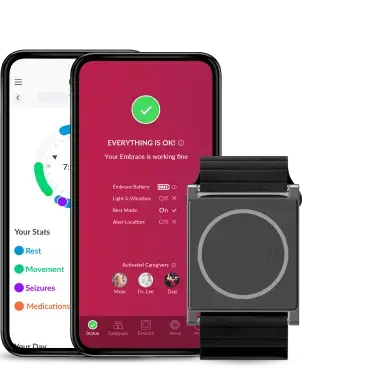New EpiMonitor Diary: Real insights for better epilepsy management
Sleep and activity are widely accepted as key indicators of health. The amount of rest we get, how much we move, and how often, all affect our overall well-being.
For people with epilepsy, these are particularly crucial. Poor sleep and activity patterns can serve as seizure triggers, influencing the frequency and severity of seizures, and overall quality of life for those affected by epilepsy.
To factor sleep and activity tracking into epilepsy management, patients and physicians need to rely on more than guesswork. This is where accurate monitoring comes into play.
Staying true to our mission of providing our users with more peace of mind, we are happy to introduce enhanced data visualization for our FDA-cleared EpiMonitor, making it the most advanced solution specifically designed for people with epilepsy.
The new update brings a brand new, intuitive My Diary design for your sleep, activity, and seizures:
- Deeper wellness insights to support you on your health journey
- A summary screen with all your day’s data in one place
- Stunning new design that changes with your data
- More metrics for more control
- Ability to zoom into each day and perform a day-by-day comparison
A brand new daily summary screen that changes with your health data
See your daily seizure, sleep and activity data at a glance, with our brand new summary screen. Each metric has its own dedicated color, so the background of the My Diary home screen changes according to the data collected, giving you a quick and intuitive overview of your daily health status.
Tapping on each metric lets you access a dedicated and more detailed diary for your chosen time period. Please note that this depends on your chosen subscription plan.
Get a breakdown of your night’s sleep with our advanced metrics
Sleep monitoring is a crucial part of epilepsy management. Not only can poor sleep be a seizure trigger, but having epilepsy can also in turn disrupt sleep patterns. [1] Accurately monitoring your sleep can play an important part in the diagnosis of epilepsy, but also in potential seizure control, and improved overall quality of life. [2]
Standard and Plus plan users can now access a dedicated screen for their sleep data, to review valuable metrics that can help unveil sleep patterns and potential trigger points:
- Sleep: Total amount of sleep per night, including tosses and turns
- Effective sleep: Time spent sleeping, excluding periods of wakefulness
- Efficiency: A percentage representing how well you slept
- Fragmentation: The degree to which your sleep was interrupted
With the combination of sleep monitoring and its algorithm that detects possible generalized tonic-clonic seizures, EpiMonitor can not only provide an overview of your sleep, it can also help identify any instances of nocturnal seizures.
Track your daily activity with accurate measurements
Living with epilepsy may lead to hesitation when it comes to engaging in physical activity, which in turn can negatively affect your overall health. Yet, exercise has been proven to improve the physical fitness, mood, cognition, memory, and overall quality of life of people with epilepsy. [3] [4]
The Epilepsy Foundation also suggests that exercise may lead to improved seizure control and reduced side effects from medication. [4]
Within the new Activity Diary screen, Standard and Plus plan users can monitor their daily activity with precision and confidence, including steps, active time, and intensity:
- Active time: Total time spent being physically active during the day
- Steps: Total steps taken
- Activity intensity:
- Vigorous Intensity: Activities that require a lot of effort and significantly raise your heart rate and breathing. Examples include running, fast cycling, or high-intensity interval training (HIIT). Vigorous activities burn more calories and contribute more to cardiovascular fitness.
- Moderate Intensity: Activities that raise your heart rate and breathing, but you can still hold a conversation. Examples include brisk walking, slow cycling, or light jogging. Moderate activity is good for improving general fitness and health.
- Low Intensity: Light physical activities that don't significantly raise your heart rate but still involve movement. Examples include slow walking, light housework, or gentle stretching. While not as intense, low-intensity activities can help with overall movement and calorie expenditure.
- Sedentary: Sedentary time refers to periods when you're mostly inactive, like sitting or lying down. Prolonged sedentary time can have negative effects on your health, so minimizing it or breaking it up with light activities is often recommended.
Keep a detailed seizure diary
The EpiMonitor Seizure Diary screen provides an in-depth record of your seizures. Review and confirm seizure events detected by our algorithm, and add detailed information for each, including triggers and any medication taken. You can also manually add other types of events yourself, to keep track of all your seizure activity in one place, including frequent times and triggers.
Sophisticated sleep and activity tracking with clinical-quality data
Using a combination of sophisticated algorithms, the sensors of our EmbracePlus wearable continuously monitor sleep patterns and activity levels. Our algorithms are developed by expert data scientists and used in some of the world’s largest and most demanding research projects, providing accuracy with no compromise so you can take control of your health with confidence.
Now available within EpiMonitor, these new insights can empower you with important information that you can use to have meaningful conversations with your healthcare practitioner. And, if you are a Plus plan user, you can always export your data as a PDF that you can easily share with your doctor.
Update your EpiMonitor app (available both on iOS and Android) or explore EpiMonitor today.
The availability of some features depends on your subscription plan, for more information visit our support center.
We do not guarantee that EpiMonitor will detect every single seizure and deliver alerts accordingly. It is not meant to substitute your current seizure monitoring practices, but rather to serve as a supplement in expediting first-response time.



